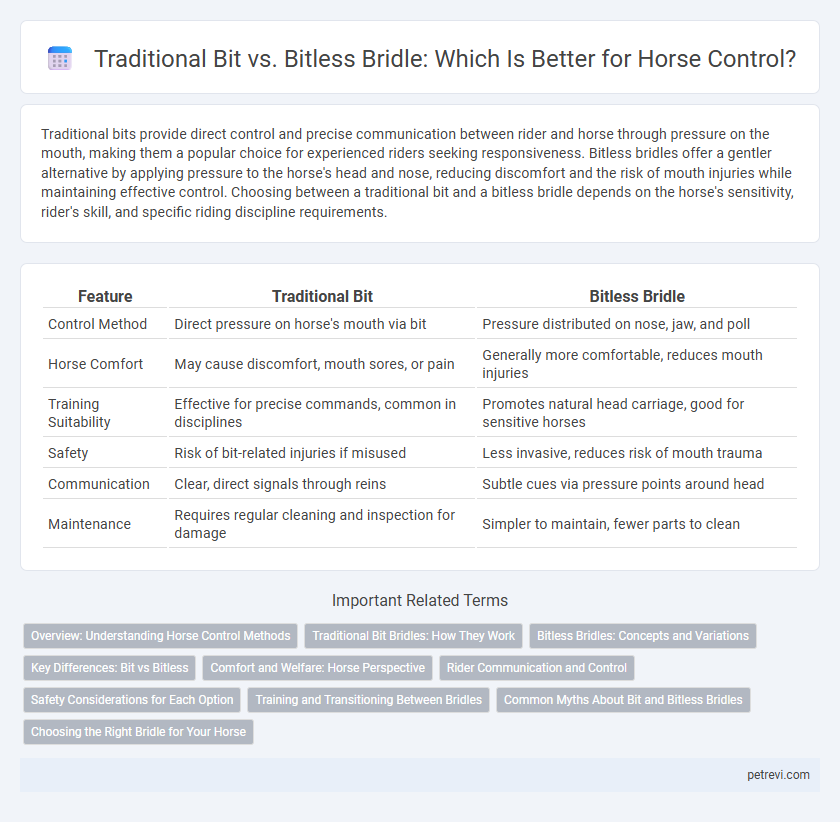Traditional bits provide direct control and precise communication between rider and horse through pressure on the mouth, making them a popular choice for experienced riders seeking responsiveness. Bitless bridles offer a gentler alternative by applying pressure to the horse's head and nose, reducing discomfort and the risk of mouth injuries while maintaining effective control. Choosing between a traditional bit and a bitless bridle depends on the horse's sensitivity, rider's skill, and specific riding discipline requirements.
Table of Comparison
| Feature | Traditional Bit | Bitless Bridle |
|---|---|---|
| Control Method | Direct pressure on horse's mouth via bit | Pressure distributed on nose, jaw, and poll |
| Horse Comfort | May cause discomfort, mouth sores, or pain | Generally more comfortable, reduces mouth injuries |
| Training Suitability | Effective for precise commands, common in disciplines | Promotes natural head carriage, good for sensitive horses |
| Safety | Risk of bit-related injuries if misused | Less invasive, reduces risk of mouth trauma |
| Communication | Clear, direct signals through reins | Subtle cues via pressure points around head |
| Maintenance | Requires regular cleaning and inspection for damage | Simpler to maintain, fewer parts to clean |
Overview: Understanding Horse Control Methods
Traditional bits apply direct pressure on a horse's mouth to communicate commands, providing precise control but requiring skilled handling to avoid discomfort. Bitless bridles work by exerting pressure on the horse's head and face, promoting gentler communication and reducing the risk of oral injury. Choosing between these methods depends on the horse's sensitivity, rider preference, and training goals, emphasizing the balance between control and comfort.
Traditional Bit Bridles: How They Work
Traditional bit bridles control horses through a metal mouthpiece resting on the tongue, bars, and lips, transmitting rider commands via pressure and leverage. This design allows precise communication, enabling riders to guide direction, speed, and head position effectively. Proper fit and skilled use are essential to ensure comfort and prevent pain or injury for the horse during riding.
Bitless Bridles: Concepts and Variations
Bitless bridles offer a humane alternative to traditional bits by applying pressure to the horse's head instead of the sensitive mouth area, promoting comfort and reducing stress. Variations include the side-pull, cross-under, and mechanical hackamore designs, each providing different pressure points and control levels tailored to horse temperament and rider preference. These bridles enhance communication and responsiveness while preventing oral injuries commonly associated with bit usage.
Key Differences: Bit vs Bitless
Traditional bits exert direct pressure inside the horse's mouth, enabling precise control through rein tension that activates the tongue, bars, and lips. Bitless bridles distribute pressure across the horse's nose, jaw, and poll, avoiding oral discomfort and reducing the risk of mouth injuries. Understanding these key differences helps riders choose control methods that balance effectiveness with the horse's comfort and sensitivity.
Comfort and Welfare: Horse Perspective
Traditional bits exert direct pressure on a horse's sensitive tongue, bars, and poll, which can cause discomfort, pain, and behavioral resistance, negatively impacting welfare. Bitless bridles distribute pressure more evenly across the horse's head, reducing stress and promoting relaxation by allowing natural head and neck movement. Studies show horses ridden with bitless bridles exhibit fewer stress indicators and improved responsiveness, highlighting enhanced comfort and overall well-being.
Rider Communication and Control
Traditional bits provide direct pressure on the horse's mouth, allowing precise control and clear communication from the rider through rein cues. Bitless bridles use pressure on the horse's head and nose, promoting a gentler contact and often preferred for sensitive or young horses while still enabling effective steering and stopping. Riders seeking enhanced subtlety in commands may find bitless bridles reduce mouth discomfort, but traditional bits often deliver more immediate and nuanced response for advanced maneuvers.
Safety Considerations for Each Option
Traditional bits provide precise control through direct pressure on the horse's mouth, but improper use can cause pain, mouth injuries, and behavioral issues, raising significant safety concerns. Bitless bridles distribute pressure over the horse's head, reducing the risk of oral damage and allowing more natural communication, which can enhance comfort and safety for sensitive horses. Selecting the appropriate option depends on the horse's sensitivity, rider experience, and specific safety needs during training or performance.
Training and Transitioning Between Bridles
Training horses with a traditional bit provides direct rein pressure, facilitating clear communication and precise control essential during advanced maneuvers. Transitioning to a bitless bridle requires gradual acclimation, as it relies on pressure points on the horse's head rather than the mouth, promoting comfort and reducing resistance. Successful transition involves patience and consistency, allowing the horse to adjust to different signals while maintaining responsiveness and trust.
Common Myths About Bit and Bitless Bridles
Common myths suggest that traditional bits cause unnecessary pain and discomfort to horses, yet properly fitted bits allow precise communication without harm. Bitless bridles are often believed to be gentler, but they require skillful handling to avoid causing pressure or confusion. Understanding the anatomy of the horse's head and proper training techniques dispels misconceptions and promotes effective control with either bridle type.
Choosing the Right Bridle for Your Horse
Selecting the appropriate bridle for your horse depends on their comfort, training level, and control needs; traditional bits provide precise control through direct pressure on the mouth, while bitless bridles offer gentler guidance by applying pressure to the horse's head without invasive mouth contact. Horses with sensitive mouths or behavioral issues may benefit from bitless options, improving responsiveness and reducing stress. Evaluating your horse's response to different bridles and consulting with equine professionals ensures the best choice for effective communication and welfare.
Traditional Bit vs Bitless Bridle for Horse Control Infographic

 petrevi.com
petrevi.com